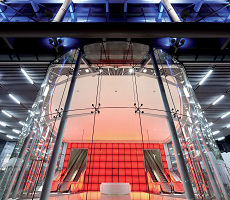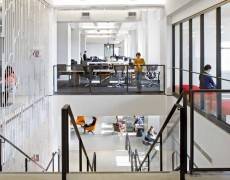April 17, 2014
Gallery: Interiors Group completes office fit-out at Instinctif Partners
 The Interiors Group has completed a project for the design and fit-out of the relocated offices for Instinctif Partners, an international business communications consultancy now situated at 65 Gresham Street, London. The relocation coincided with the launch of Instinctif Partners’ new name (having previously been known as College Group) so the new design became an expression of the new identity. The office fit-out project includes joinery, the installation of a media wall, bespoke feature walls, reception desk and lighting. The flooring consists of porcelain tiles and carpet from Interface. The backlit reception desk displays the client’s twelve corporate colours on rotation. Leather seating was specified for the visitors’ waiting area. The open plan office is designed as a circular newsroom with a high table in the heart of the space highlighted by an oversized dome pendant. The dining area has been fitted out with LED screens and furnished in white. More →
The Interiors Group has completed a project for the design and fit-out of the relocated offices for Instinctif Partners, an international business communications consultancy now situated at 65 Gresham Street, London. The relocation coincided with the launch of Instinctif Partners’ new name (having previously been known as College Group) so the new design became an expression of the new identity. The office fit-out project includes joinery, the installation of a media wall, bespoke feature walls, reception desk and lighting. The flooring consists of porcelain tiles and carpet from Interface. The backlit reception desk displays the client’s twelve corporate colours on rotation. Leather seating was specified for the visitors’ waiting area. The open plan office is designed as a circular newsroom with a high table in the heart of the space highlighted by an oversized dome pendant. The dining area has been fitted out with LED screens and furnished in white. More →




























April 9, 2014
The Wall Street Journal (and others) are wrong about human resources
by Mark Eltringham • Comment, Workplace
More →